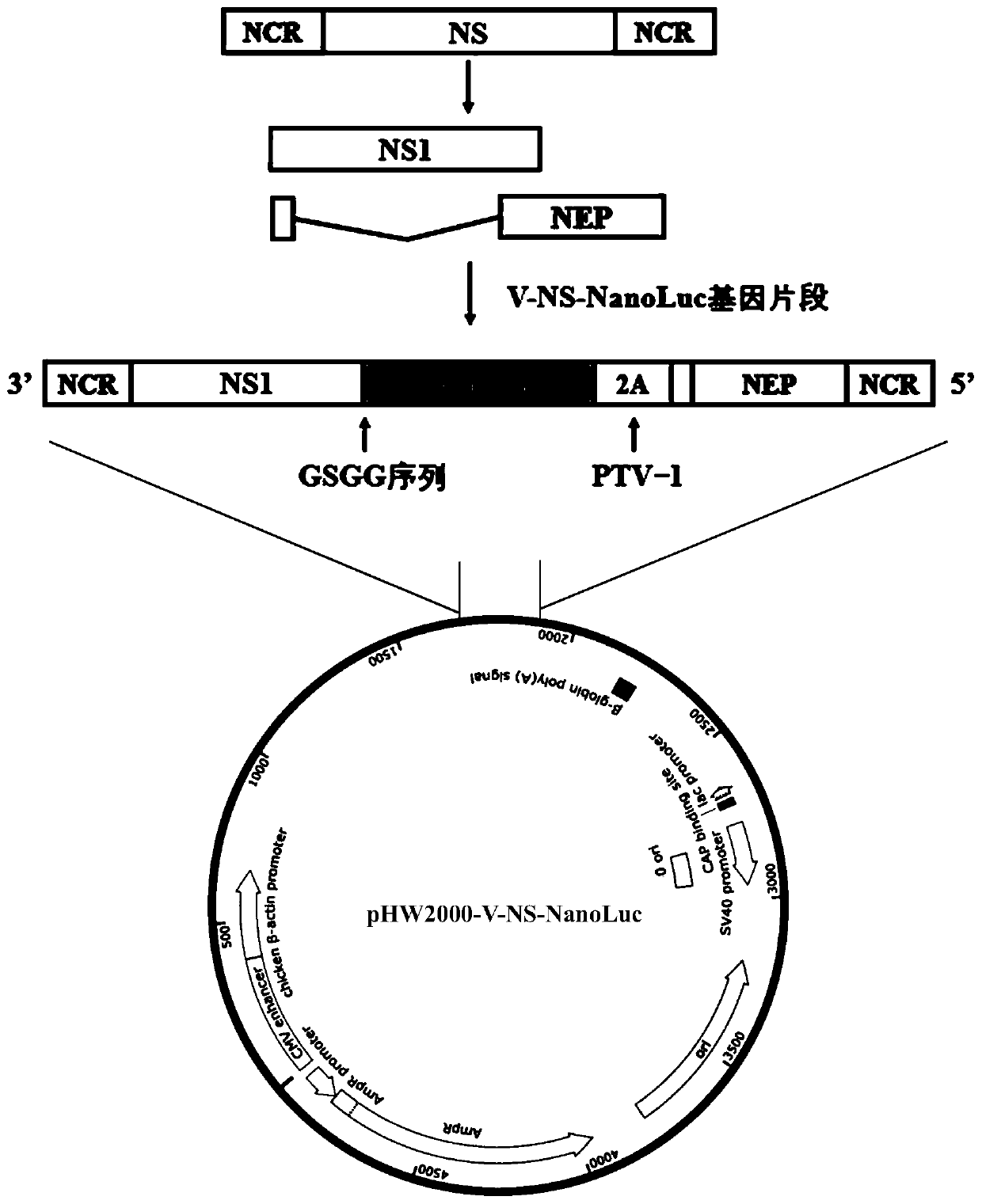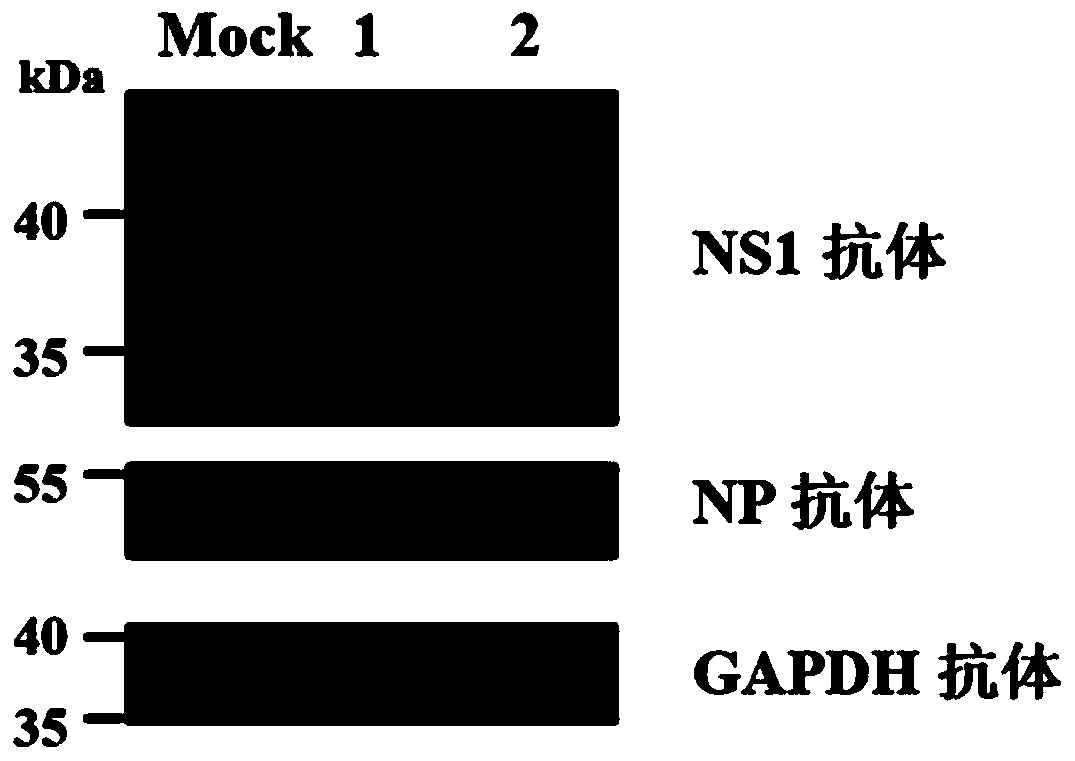Recombinant avian influenza virus carrying NanoLuc gene and application thereof in living imaging mouse model
An avian influenza virus and recombinant virus technology, which is applied in the fields of molecular biology and genetic engineering, can solve the problem of not carrying recombinant H9N2 subtype avian influenza virus, etc., and achieves the effect of good stability
- Summary
- Abstract
- Description
- Claims
- Application Information
AI Technical Summary
Problems solved by technology
Method used
Image
Examples
Embodiment 1
[0059] The construction of the NS gene recombinant plasmid pHW2000-V-NS-NanoLuc, the steps are as follows: The schematic diagram of the recombinant plasmid construction is as follows figure 1 As shown, the sequence of the V-NS-NanoLuc fragment is shown in SEQ ID NO.1: the protective base of the head-end restriction endonuclease Aar I and its recognition site (position 1-18), the NS segment of V virus 3' end non-coding region sequence (position 19-44), sequence of V virus NS1 segment coding region (excluding terminator) (position 45-695), Linker (GSGG) sequence (position 696-707), NanoLuc luciferase gene sequence (without terminator) (708-1220), PTV-1 virus 2A peptide coding sequence (1221-1286), V virus NEP segment coding sequence (1287-1652 ), the sequence of the 5' non-coding region of the NS segment of the V virus (position 1653-1678), the protective base of the terminal restriction endonuclease Aar I and its recognition site (position 1679-1697). The V-NS-NanoLuc fragment...
Embodiment 2
[0063] Rescue the recombinant H9N2 subtype avian influenza virus V-NS1-NanoLuc carrying the NanoLuc luciferase gene by reverse genetics, the steps are:
[0064]293T cells were inoculated in 6-well cell plates and cultured with DMEM cell culture medium containing 10% fetal bovine serum (293T cells were purchased from ATCC; fetal bovine serum (FBS) was purchased from Israel Biological Industries; DMEM cell culture medium was purchased from In Gibco Company), the next day, the eight plasmids pHW2000-V-PB2, pHW2000-V-PB1, pHW2000-V-PA, pHW2000-V-HA required for the influenza reverse genetic system carrying the NanoLuc luciferase gene , pHW2000-V-NP, pHW2000-V-NA, pHW2000-V–M and pHW2000-V-NS-NanoLuc (0.6 μg / plasmid) were co-transfected into 6-well cell plates, and after 4-6 hours of transfection, discard The culture medium was removed and replaced with Opti-MEM medium containing 0.2 μg / mL TPCK trypsin and a final concentration of 0.2% BSA (bovine serum albumin). After 48 hours of...
Embodiment 3
[0066] The recombinant H9N2 subtype avian influenza virus carrying the NanoLuc luciferase gene is passed on the SPF chicken embryo, and the steps are as follows:
[0067] The allantoic fluid of HA-positive chicken embryos obtained in the previous generation (i.e. V-NS1-NanoLuc recombinant virus) was diluted 100 times with PBS, and then 100 μL of the allantoic fluid was inoculated into 9-day-old SPF chicken embryos, incubated at 37°C for 72 hours, and HA was collected Positive chick embryo allantoic fluid was stored in a -80°C refrigerator. This operation was repeated 4 times, and the obtained virus generations were named P1-P4 in order.
PUM
 Login to View More
Login to View More Abstract
Description
Claims
Application Information
 Login to View More
Login to View More - R&D
- Intellectual Property
- Life Sciences
- Materials
- Tech Scout
- Unparalleled Data Quality
- Higher Quality Content
- 60% Fewer Hallucinations
Browse by: Latest US Patents, China's latest patents, Technical Efficacy Thesaurus, Application Domain, Technology Topic, Popular Technical Reports.
© 2025 PatSnap. All rights reserved.Legal|Privacy policy|Modern Slavery Act Transparency Statement|Sitemap|About US| Contact US: help@patsnap.com



